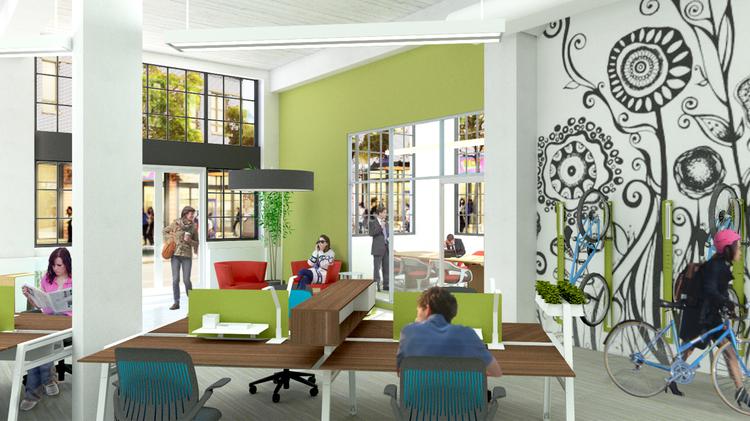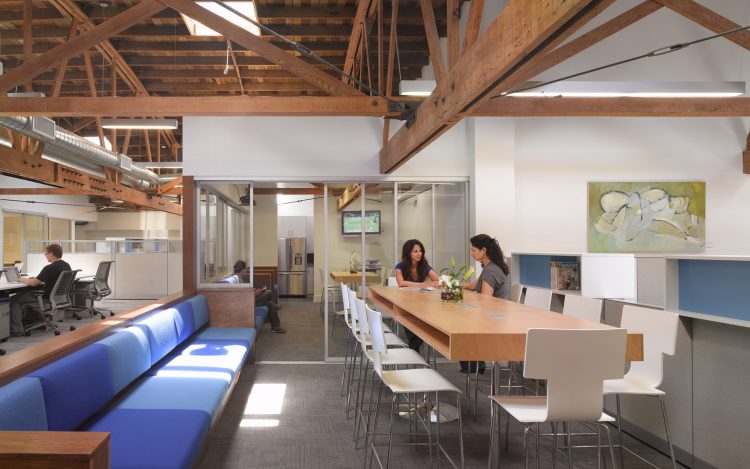The Social Workplace to become the next mainstream office environment
DTZ UK, via the Financial Times, recently disclosed a survey which stated that 816 coworking spaces are active in the city of London today. If the definition of coworking withheld by the real estate consulting firm in fact did embrace the wide scope of flexible workspaces (including business centers) the figure then confirms that traditional offices and businesses are now leaning heavily towards innovative and social work environments.

Spacious, New York
The trend is gaining traction in a growing number of cities. According to the CoStar’s ranking, in the 1st half of 2015, coworking champion, WeWork, was the number 1 deal taker in the New York City’s real estate market.
In the Big Apple alone, WeWork now operates more than 549.000 square feet (51.000 m2) of space, spread across 15 locations, which is part of a network of 49 spaces.
But the story is not only about WeWork.
In the last 12 months, the coworking scene, on the whole, raised close to 1 billion US$.
A brand new, growing industry
Today the story that is being written is focused on a new and growing industry, which is beginning to shake up the traditional office market. Today’s businesses are reimagining the role, function, and spirit of the 21st-century workplace.
The culture of work is changing and so is the physical workplace, as it is preparing to embrace a future that will be social, open, comprised of peer to peer networks, as well as convenient and human driven.
This current shift implies a new understanding of workplace tenants’ untold expectations. Today, there are more than 6.000 coworking spaces operating around the world. These spaces range from big to small, financially self-supported incubators, business centers, and even universities. It has become common knowledge that by identifying a position and nurturing a community, these spaces will manage to sustain a successful platform for future workers.
The Social Workplace, whether it is comprised of hot-desking, open spaces, lounges or private offices, is thought to better enable human interactions and a sense of belonging.
Inspiring design and facilitation
It comes as no surprise that after one decade of coworking, social connections, open access, sense of belonging and like-mindedness, do indeed matter. Because of this understanding, these practices can be implemented on a bigger scale, either by newcomers or by existing coworking space operators who have managed to grow over the years.
Important players within the movement are now entering the era of the Social Workplace, where the whole facility and workspace environment, whether it is made out of open space hot-desking, fixed desk renting, lounges or private offices, is thought to better enable social interactions and on-demand services.
As a result, physical spaces that are home to these communities have become micro-ecosystems, based on the tenants’ personal values and modern work styles. This value proposition adds to the direct economic advantages of operating activities from a shared workspace, namely flexibility and lower costs, allowed by the mutualization of some facilities. Successful social workplaces speak as much to the users’ heart and emotions as they do to their brain and wallet.
Successful social workplaces speak as much to the users’ heart and emotions as they do to their brain and wallet.
Spaces.
An opportunity generator for independent workers and businesses
As the workforce becomes more independent and digitally distributed, new needs emerge, which have created the ability to multiply business opportunities. This new style of work breaks isolation and supports a dynamic and positive community of peers that can team up rapidly for short-term projects while also giving them the chance to discover complementary skills. It is important to remember that modern workers want to move away from a purely functional work environment.
The shift we are currently witnessing is all about a new work style and values. A greater openness for social interactions also means more informality and innovative ways to approach social engagement, as we often see online.
This alchemy within the Social Workplace can occur through the concourse of two main ingredients:
- A well thought out space design and layout, which is reflective of the contemporary values of the tenant community. This space plays an important role in fostering informality, engineered in such a way that it can offer a balance between quiet productive areas, private, meeting and social/convivial zones, which can ensure socializing and fluid space. Some social workplaces aim to look like a personal living space. Others stress the sleek and cool aesthetic focused on technology while some prioritize creativity. It is vital that the look and feel of the workspace will be inspiring and that the layout is efficient and based on “social ambition”.
- Personal facilitation and hospitality. The added value of flexible space owners isn’t just about the provision of functional services to tenants. Today, many spaces can be operated from an individual laptop, but added value must also be focused on care and intention, community building, networking and content through the regular hosting of events.
It goes without saying that undertaking such new endeavors requires the social workplace owner to embrace new skill sets as well as the appropriate culture that goes with it.
Pure player coworking spaces have been putting these principles in place since the beginning
Social workplaces operate on a bigger scale, and often in much larger spaces. They tend to mix coworking and private offices, as well as meeting and event rooms. There is often a coffee shop, sometimes a restaurant (offering catering services) plus additional programs (training, coaching, business acceleration, for instance). And, of course, community facilitation.
Various international players have also successfully implemented this model. Let’s mention The Office Group (UK), Spaces (The Netherlands) or, again, WeWork (US) to name a few. The coworking pioneer Betahaus is also an inspiration to the growing community of Social Workplaces. Betahaus Berlin HQ now occupies an entire building from which they initially started as a small to mid-sized coworking space. It has a fully equipped cafe on the ground floor, coworking and dedicated desks, in additional to a Maker Lab, training course, and in-house startup support.
The Office Group
WeWork
Betahaus
The road towards work villages?
If these social principles can take over a whole building, the next step might be to outline a whole neighborhood according to the same value system.
This is the philosophy behind the Urban Escape project in Stockholm. In this case, the Social Workplace isn’t just a building but a whole city block. Coworking, network and event offerings are at the core of this project, just as it is within a growing number of urban development projects around the world.

Woodstock Exchange, Cape Town (South Africa)

Bespoke, San Francisco
Another prime example of this model is the Woodstock Exchange, based in Cape Town (South Africa). The real estate development platform has integrated restaurants, coffee shops and craft stores into the mix. The rest of the compound hosts flexible offices and coworking spaces for freelancers, startups, and agencies from the creative and digital industries.
These Social Workplaces are also moving into our daily lives. Bespoke, based in San Francisco (US), is set up in the center of a shopping mall, blurring more and more the boundaries between work and our private lives.
The lines become even more blurred as coworking is now offering more diverse services, such as sports centers and accommodation. Spacious project in New York City (see picture upside) is an aggregation of a hotel and open coworking space. Before, there were other innovative platforms that were established within the collaborative economy (co-living, shared cars, on-demand services, etc.) that are now becoming a part of these developing social workplaces.
Jean-Yves Huwart
Social Workplace Conference
Subscribe to our Newsletter by clicking HERE.
Register to the Social Workplace Conference :


The Social Workplace Conference (London, October 16th 2015) is a unique opportunity to understand the innovation taking place within flexible workspaces that are rapidly transforming the real estate landscape. The conference explores various work landscapes and their relationship with coworking for the 1st time ever. The event will be discussion based, aimed at promoting the coworking movement’s success at integrating the human experience within the modern workplace.











Recent Comments